Biomimicry Shoe by Marieka Ratsma and Kostika Spaho

A bird’s skull inspired the hollow heel of these 3D-printed shoes by Dutch fashion designer Marieka Ratsma and American architect Kostika Spaho. Ratsma and Spaho used the shape of a bird’s cranium for the front of the shoe, with the tapered beak as the spike of the heel. The lightweight and efficient structure of the hollow skull allowed the shoe to be 3D-printed using less material. Other 3D-printed shoes we’ve featured on Dezeen include ‘invisible’ and mirrored designs by Andreia Chaves and a bespoke pair by Marloes ten Bhömer.
The apex predator shoes

Fantich and Young made the Apex Predator Shoes in 2010. In 2011, they fashioned a matching Savile Row suit out of human hair, glass eyes, and more teeth. Last month they tweeted about the shoes, and the powers that run the Internet have been sharing them up every since. Pretty rad, huh? I only wish Fantich and Young had colored the soles pink, so I could have made a “gumshoes” pun. But that’s just me. Click through for a few more snaps of the shoes. The Apex Predator Shoes by London-based Fantich and Young.
Iris van Herpen’s Crystal-esque 3D printed dress & shoes
Although we’ve seen quite the gamut of 3D printed fashion designs, many have been limited by the cost of producing them which can oftentimes be much more than those made by traditional manufacturing processes and frankly, a lot less comfortable. Regardless, using 3D printing to create a variety of goods ranging from dresses to shoes is something that probably isn’t going to go away anytime soon and thanks to more advanced methods of additive manufacturing, methods that used to be much more expensive have come down in cost considerably.
Among those who is no stranger to using 3D printing in her designs is Dutch designer Iris van Herpen. In combining both traditional craft techniques with digital fabrication, the artist/designer has made a name for herself as a true revolutionary in the world of fashion when it comes to using 3D printing on the runway. The designer’s most recent collection for Fall/Winter 2015-16, titled “Hacking Infinity”, debuted at Paris Fashion Week earlier this month.
Among other pieces in the collection was an SLA 3D printed dress that van Herpen designed in collaboration with architect Niccolo Casas and was fabricated by using a 3D Systems’ ProX 950 SLA printer.
According to Casas, the main aspiration for the new dress design was the combination of motion and complexity; the dress acts as an ecosystem of unique individual components that continuously react to the body’s movement. In total, there are over 6556 different components that make up the entirety of the outfit’s “ecosystem”.
In order to print the dress, four panels were 3D printed in the transparent Accura ClearVue material by 3D Systems’ Quickparts on-demand 3D printing service. 3D Systems helped the designers optimize their 3D files before spending nearly 200 hours printing the objects and hours more just to remove the support material.
Nihilism clothing by DZHU
S can be folded into different austere shapes

Womenswear brand DZHUS is continuing its reputation for austere and architecturally precise garments with the Nihilism collection, designed for the “crazy rhythm of modern life”. The range features tops and trousers with distinctive angular shapes and folds, as well as coats with dramatically pointed hoods. The clothes are designed as basic pieces that are easy to unzip and unfold, offering different options for wearers.
“Everything we use nowadays has to be functional, compact and mobile to help us cope with the crazy rhythm of modern life,” said Ukrainian founder Irina Dzhus, who launched the label in 2010.
The collection is made from felted knit, denim and cotton – chosen to reflect the industrial design of the clothes. Dzhus selected felt textures reminiscent of concrete – her “great passion” – and cotton, as it’s often used in workers’ uniforms.
Intimacy 2.0
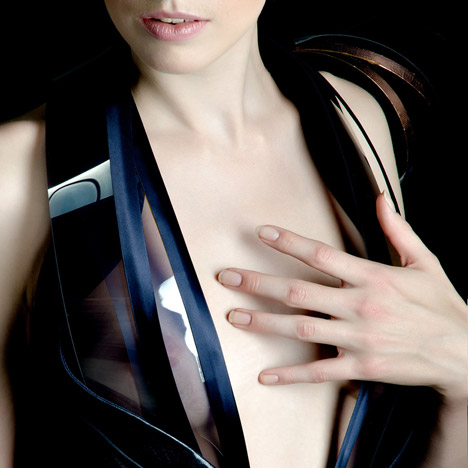
Created by Dutch designers Studio Roosegaarde and Anouk Wipprecht, the clothing is made from leather and electrically-sensitive foils that become opaque or transparent according to alterations in voltage.

The Intimacy 2.0 garments are a follow-up to the first collection of Intimacy dresses, which become see-through when approached.
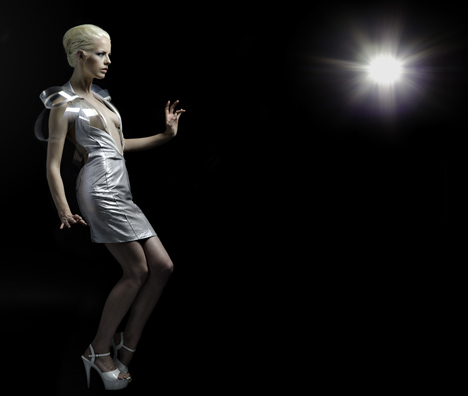
Here’s a couple of extra details from the designers:
INTIMACY 2.0 features Studio Roosegaarde’s new, wearable dresses composed of leather and smart e-foils which are perfect to wear on the red carpet.

In response to the heartbeat of each person, INTIMACY 2.0 becomes more or less transparent.
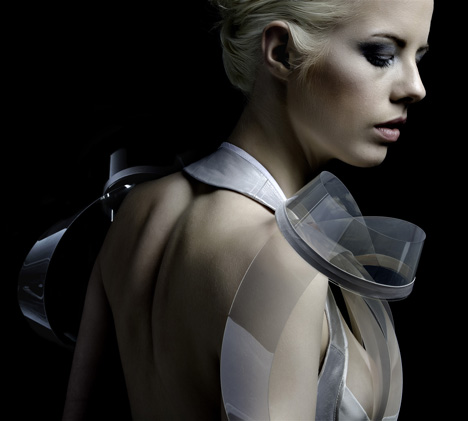
Nikolas Bentel designs shirts that change colour when exposed to air pollution
New York designer Nikolas Bentel has developed a range of patterned shirts that change colour in response to air pollution or radioactivity (+ movie). Bentel’s Aerochromics collection of three cotton shirts has patterns printed in a colour-changing dye that Bentel claims has never before been applied to consumer clothing.

Each piece is named after and features a pattern inspired by the pollutant it reacts to, from carbon monoxide and particle pollution to radioactivity.
“I am personally interested in pollution and global warming,” Bentel told Dezeen. “A lot of my work is some form of social design.”

“The science for all of these pieces of clothing exist and is easy to find, but it has never been applied to consumer-grade clothing.”
The Carbon Monoxide shirt functions in a similar way to a carbon monoxide spot detector, which features a patch that turns black when carbon monoxide is present and clear when the air around it is stabilised.

As carbon monoxide comes into contact with the shirt, the gas is oxidised by chemical salts in the dye, a process that changes the dye’s colour to white as it loses oxygen atoms.
Once the carbon monoxide’s removed from the air, different chemical salts made from metals absorb oxygen from the air. This changes the dye back to its original chemical form, and the colour to black again.

The Particle Pollution shirt changes colour through a thermo-reactive dye. It features two small sensors, one on its front and one on its back.
When the shirt is exposed to particle pollution like dust, soot or smog, the sensors alert a small controller embedded into the collar of the shirt.

Each dot in the pattern is connected to a circular heat pad that is activated by the controller, making the thermo-reactive dye change colour as the patch heats up.
The dye on the Radioactivity shirt changes from black to white depending upon gamma rays or electron beam radiation. As exposure increases, the pattern becomes darker and darker, and once you have been exposed to too much radiation, the shirt will not change back to black.

Bentel isn’t the first designer to create clothes that respond to their environment. Two engineering professors from the University of California created a bikini that absorbs pollution from the sea, and a team of Dutch designers developed a garment that purifies the polluted air surrounding the wearer.
Meanwhile, Dutch designers Studio Roosegaarde and Anouk Wipprecht created clothing that responds to the wearer, turning transparent in response to excitement or embarrassment.
“Responsive garments are everywhere right now, from the Apple Watch to many speculative projects,” said Bentel. “I believe that there is a need for more natural interfaces.”
“If a user can communicate with the objects that they are already using such as the shirt on their back, then there should be no need for extra gadgets.”
3D-printed Adidas trainers go on sale
Adidas has released a limited-edition run of its 3D-printed trainers, which were worn by a number of athletes at this year’s Rio Olympics.
The 3D Runner goes on sale today at stores in London, New York and Tokyo – marking the first time that Adidas shoes incorporating 3D-printing technology have been available to purchase.
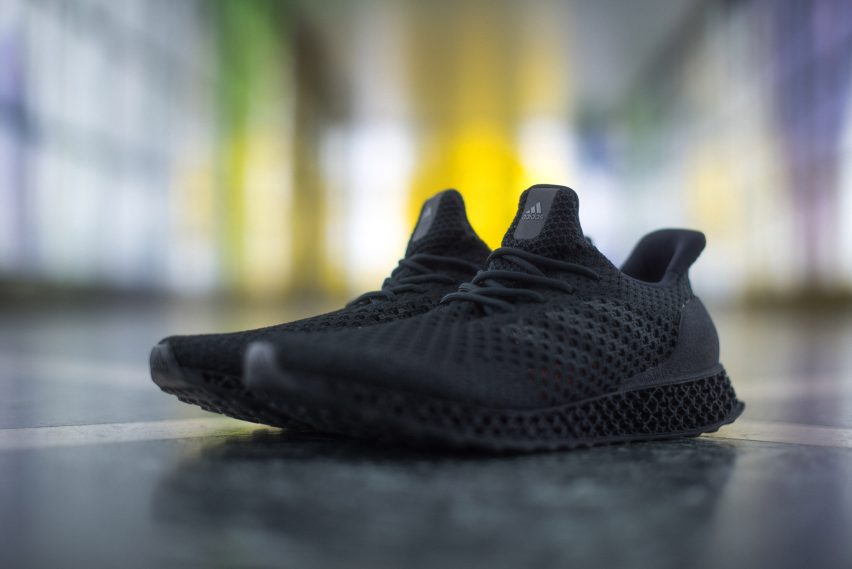
The shoe features many similar elements to the Futurecraft trainersunveiled in 2015, which had 3D-printed soles to mimic runners’ footprints.
The shoes’ midsole is made from a 3D-printed web-like structure, with denser zones in high-force areas and less dense zones in low force areas.
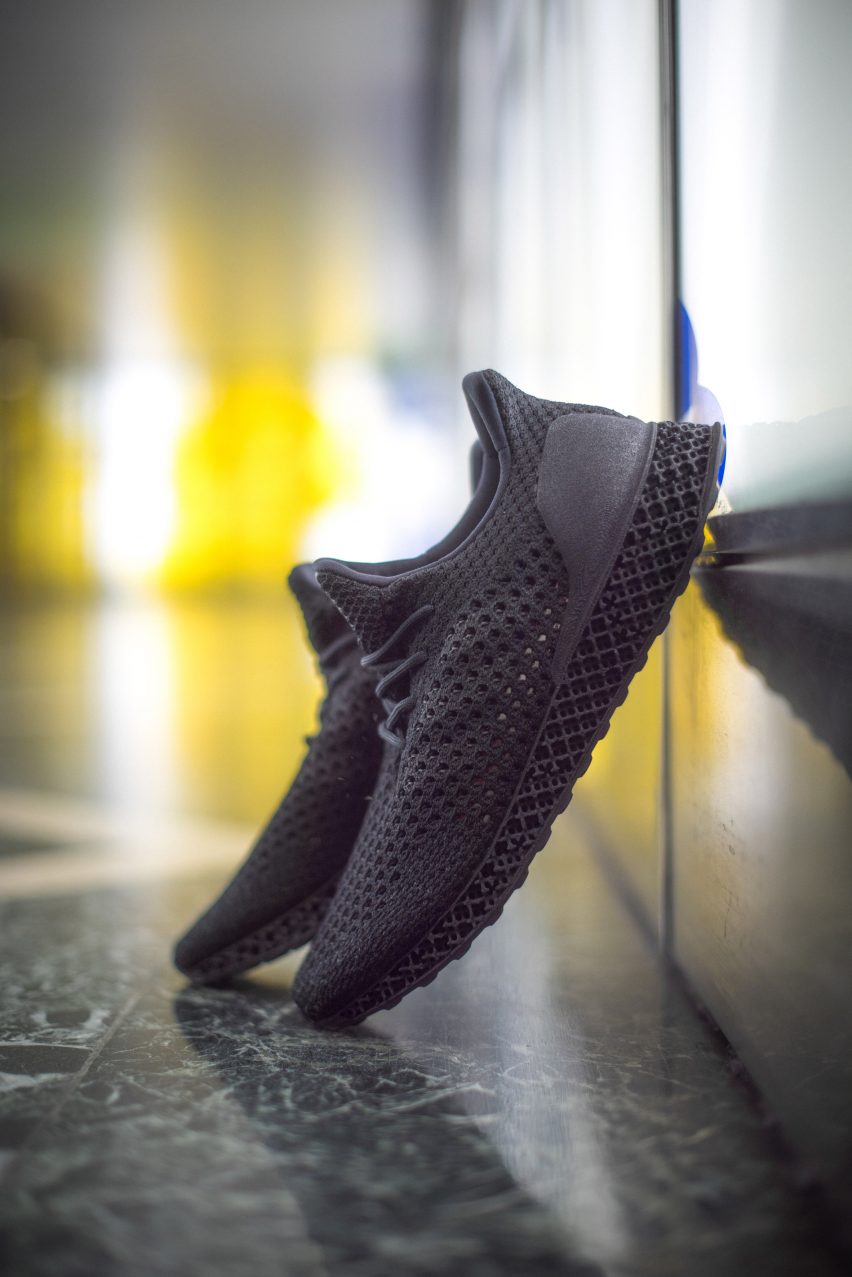
A 3D-printed heel counter, the plastic insert used to reinforce the heel cup of a shoe, is integrated into the midsole – negating the need for glueing or stitching.
The upper of the shoe is made using Adidas’ Primeknit technology, meaning that it is both light and flexible.
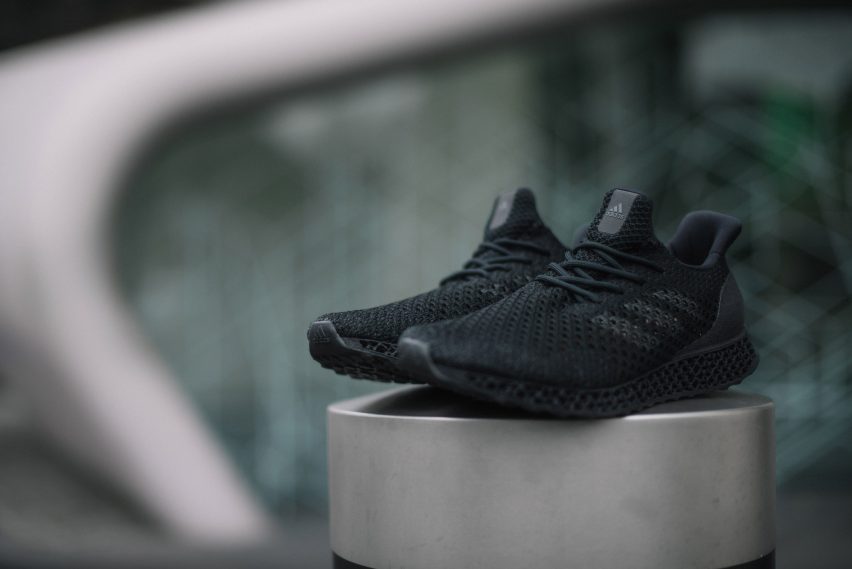
The 3D Runner was first unveiled by Adidas in August at the Rio Olympics when a number of athletes, including Team GB heptathlete Jessica Ennis-Hill and USA swimmer Allison Schmitt, wore them during the medal ceremonies.
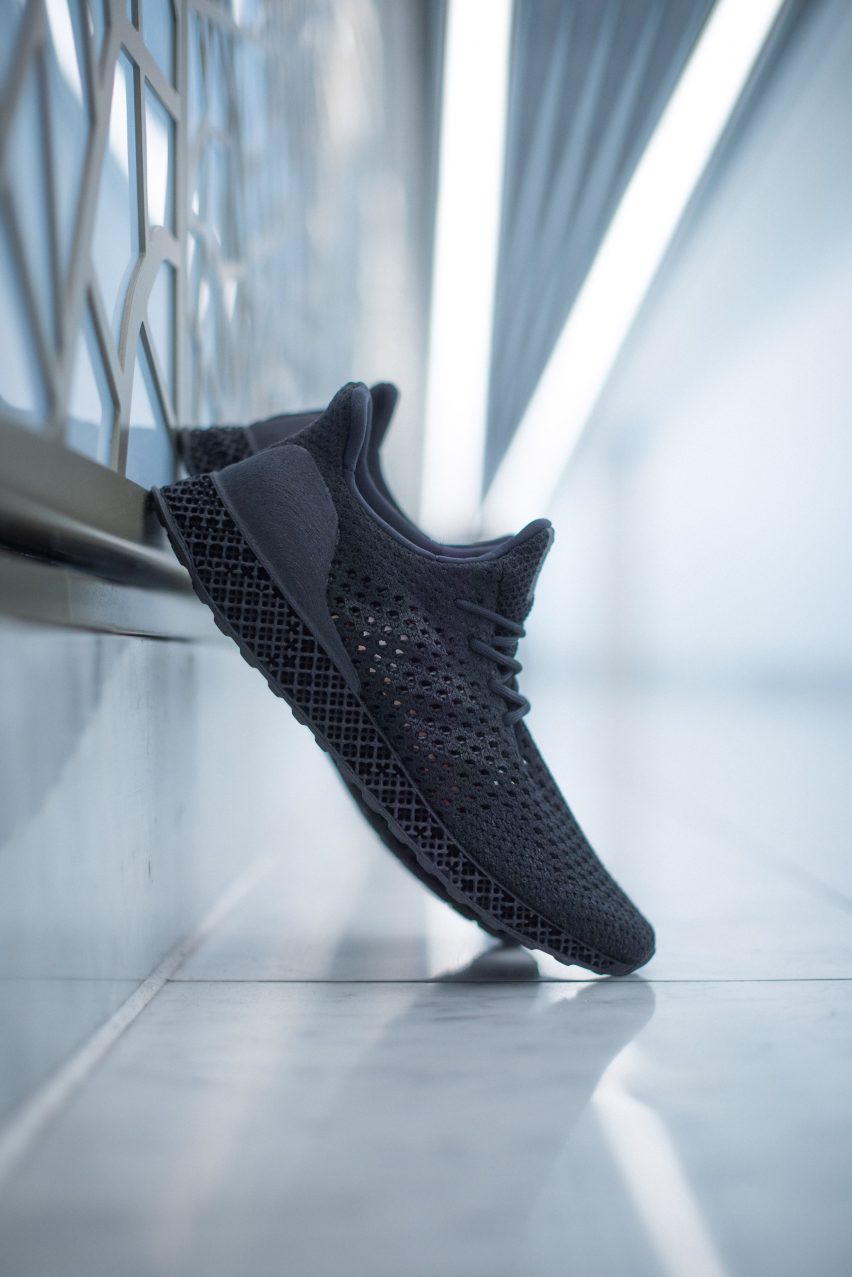
Adidas has become known for pushing the boundaries of sneaker innovation, gaining it a place on the inaugural Dezeen Hot List, ahead of Nike.
This year, it has unveiled the Futurecraft Tailored Fibre trainers, constructed through an industrial sewing technique used to manufacture heated car seats, and a version of the brand’s Superstar trainer featuring a seamless upper made from a single piece of leather.
Earlier this month, the brand revealed it would be making one million pairs of its ocean plastic shoes in 2017, with the ultimate ambition being to eliminate virgin plastic from its supply chain.
Speaking to Dezeen last year, Adidas executive board member for global brands Eric Liedtke said that the company aims to use design to challenge its arch-rival Nike as the dominant brand in the American market.
“I need to overcompensate in America from a design point of view,” he said. “I need to get this right [in the USA], because we’re not having the success we are in Europe right now.”
Clothes dissolve on the catwalk during Hussein Chalayan’s Spring Summer 2016 show
Designer Hussein Chalayan’s Paris Fashion Week show featured a catwalk shower that dissolved a pair of soluble outfits, revealing delicate garments underneath (+ slideshow).
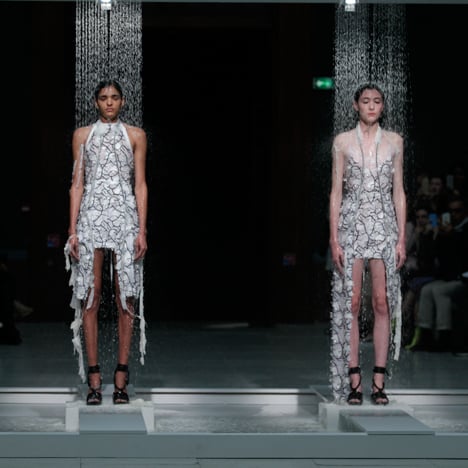
The presentation of melting clothes was part of the Chalayan Spring Summer 2016 show, which took place in the Salle Melpomène at Paris’ Palais des Beaux-Arts earlier today.
Two models wearing white thigh-length jackets stood on small podiums within a large tray-like area in the centre of the catwalk. A low portion of ceiling was punctured by holes positioned above the models.
As water poured down through the gaps, the clothes began to disintegrate and fall away as if made from tissue.
The dresses revealed underneath were patterned with lines of thick black stitching and appliqué white petal shapes, each of which had clear jewels attached below.
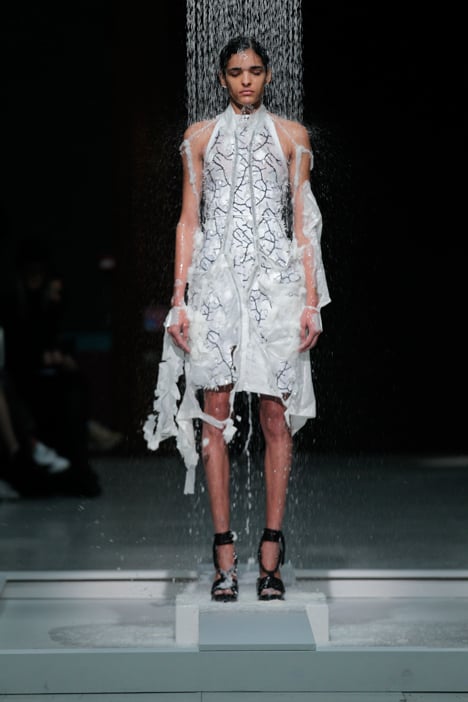
Chalayan is renowned for his experimental fashion designs. His previous collections have included two-in-one dresses that transform with a single tug and garments that emit laser beams. The rest of the collection comprised black-and-white designs, floral patterns, and red and camel-coloured outfits made from lightweight fabrics.
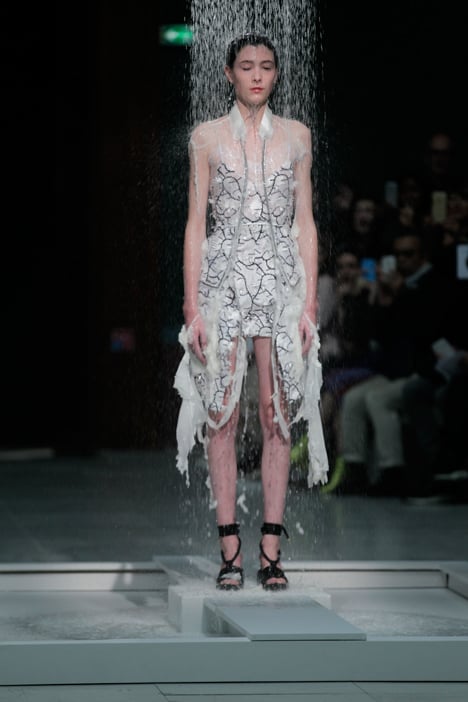
Shoes with cylindrical wooden blocks for heels and leather uppers were tied to ankles using lengths of rope. A few mens looks also featured in Chalayan’s predominantly womenswear range.
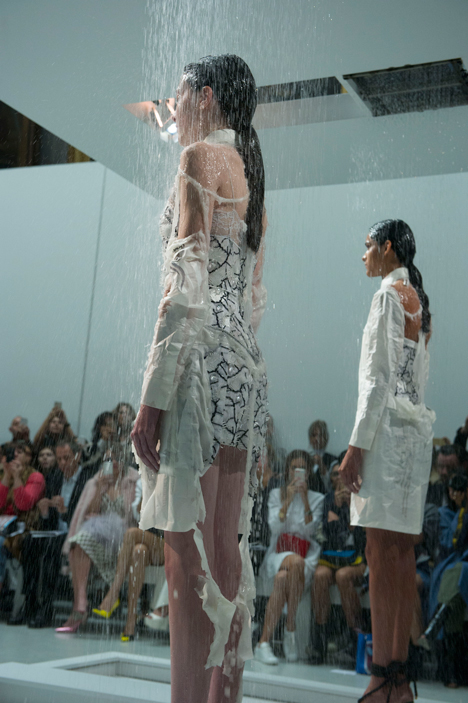
The Cyprus-born British designer celebrated his 21st year in business this year, and opened his first store in London’s Mayfair to coincide with the anniversary.
Viktor & Rolf mixes Picasso and polo shirts for Spring Summer 2016 haute couture
Dutch fashion house Viktor & Rolf has continued its “wearable art” theme with an haute-couture collection of sculptural white garments made from Cubist facial features.

Viktor & Rolf’s The Performance of Sculptures was shown yesterday at Paris’ Palais de Tokyo, during the city’s haute-couture fashion week.
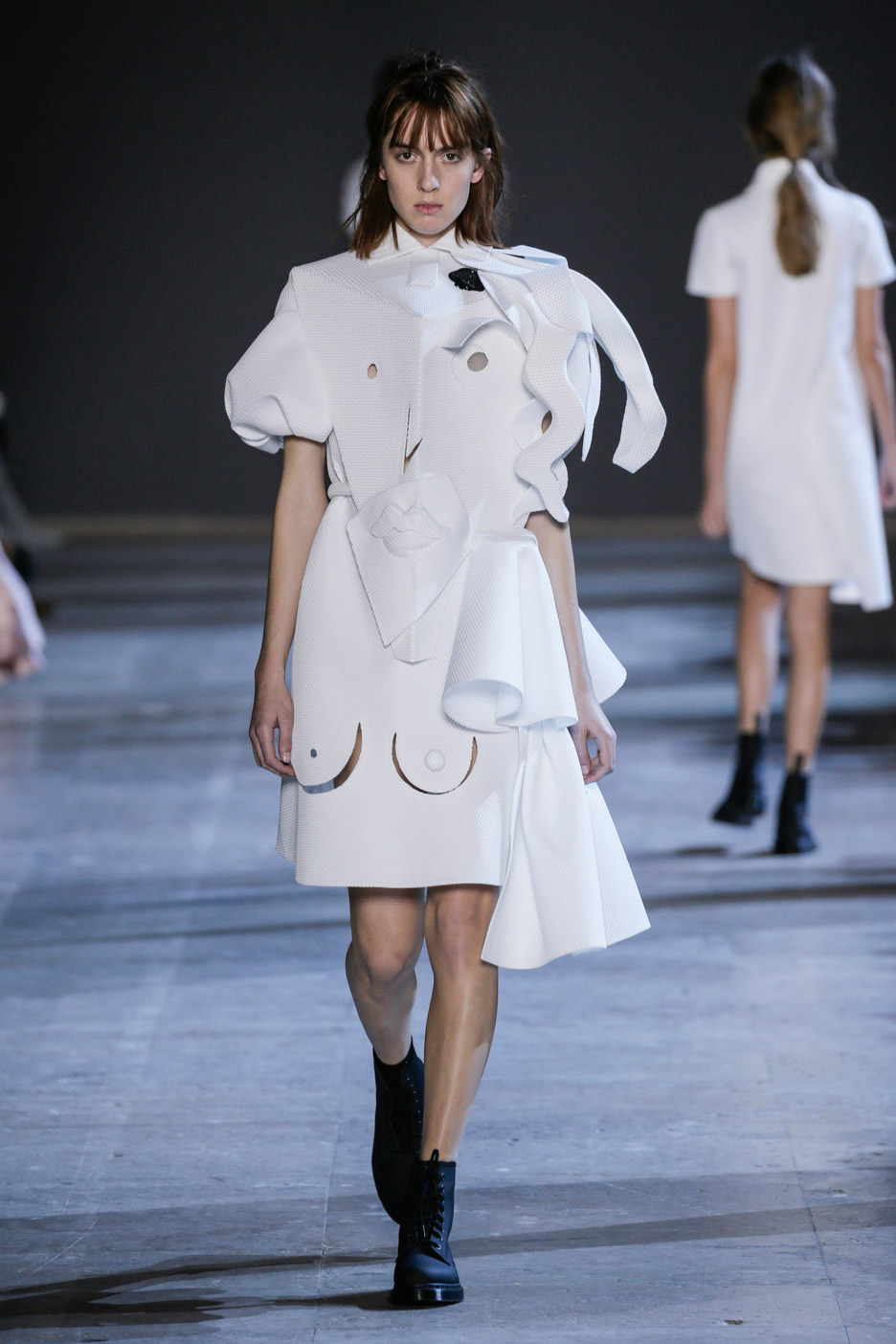
The Spring Summer 2016 range builds on previous art-influenced collections, including last season’s wearable paintings and an earlier range of garments based on Van Gogh artworks.
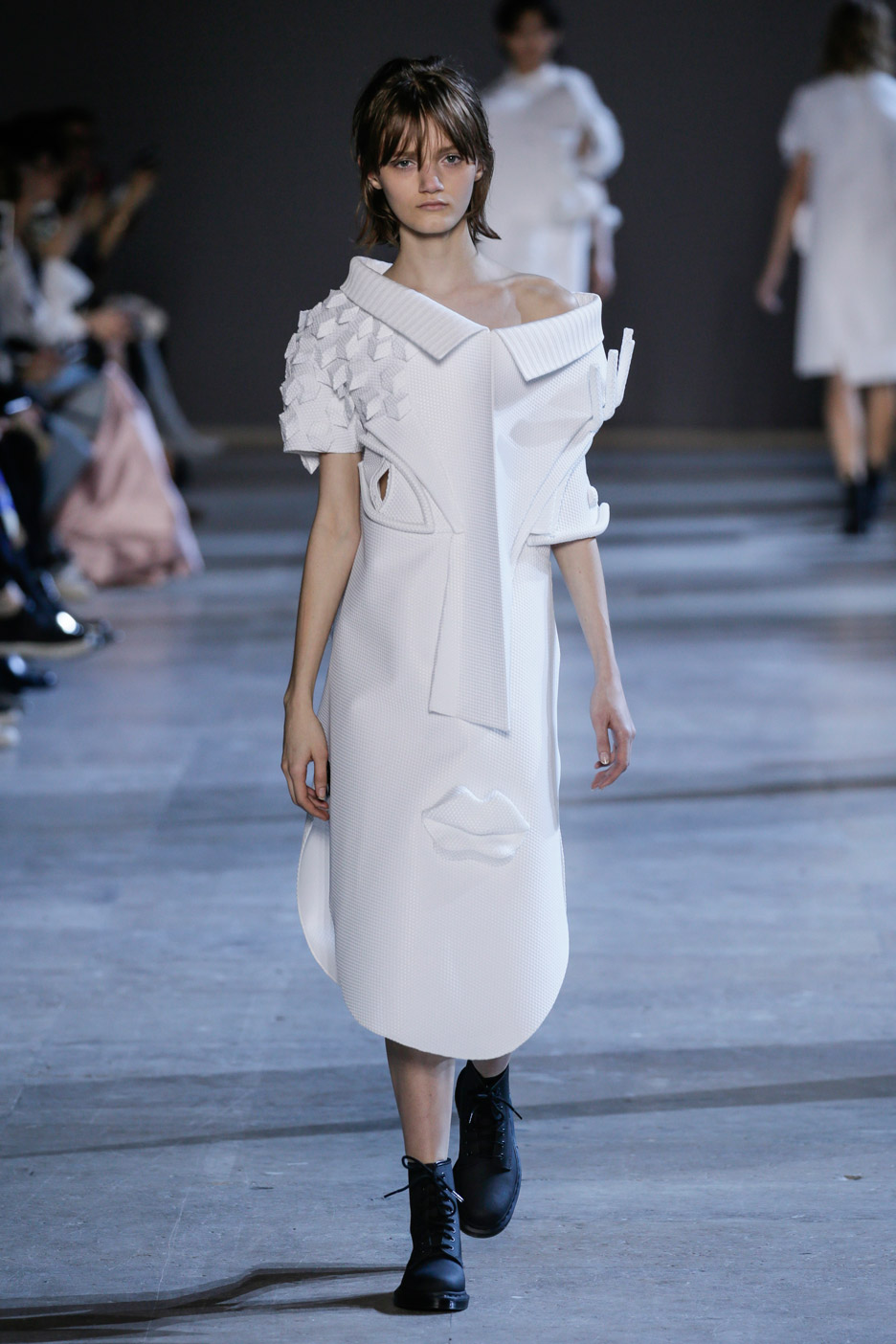
The starting point for the most-recent collection was the simple white polo shirt, which the designers fused with the work of another famous artist: the Spanish Cubist, Pablo Picasso.
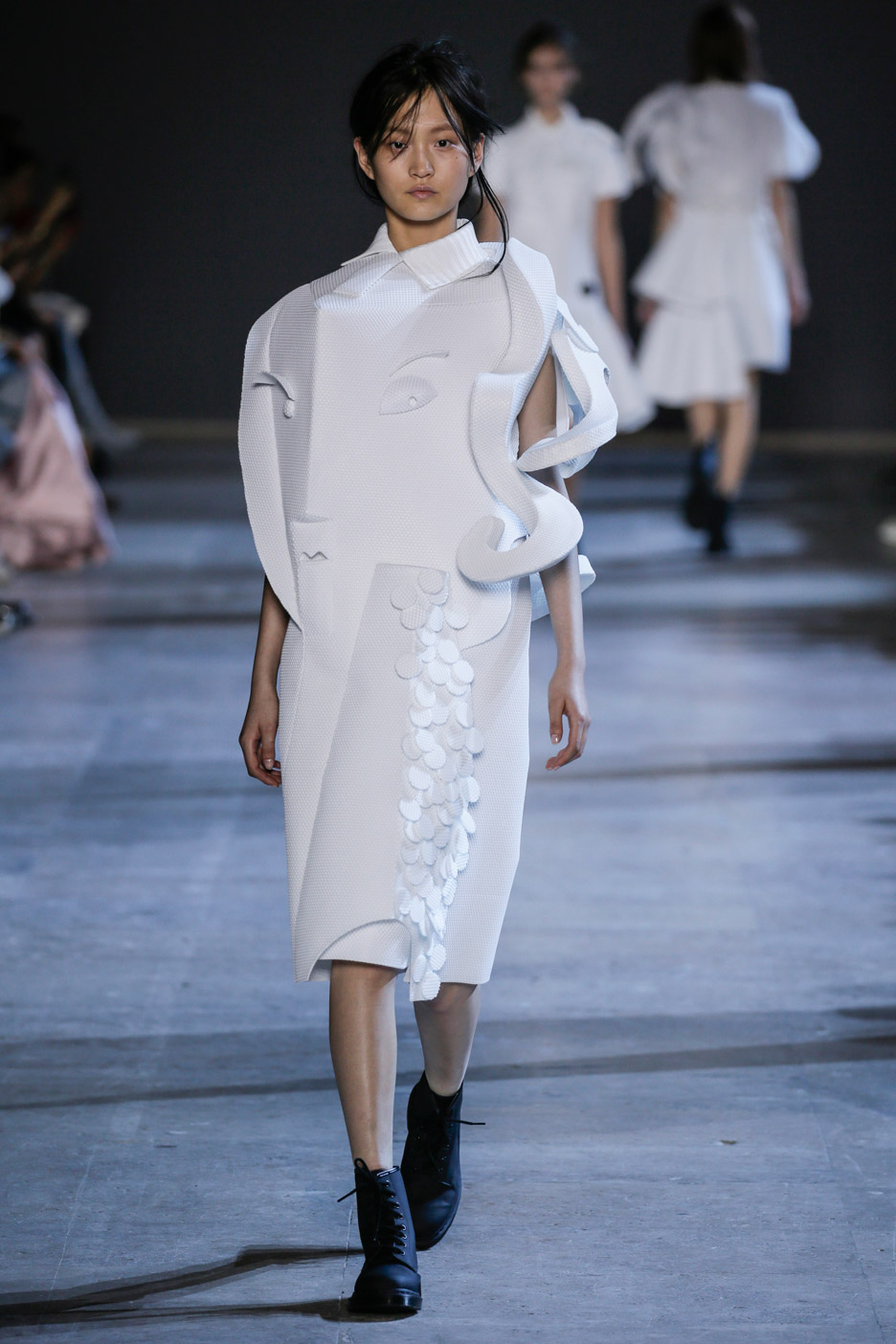
“This season, the collection explores the idea of the archetypical white polo shirt meeting Cubism,” said a statement from Viktor & Rolf, which decided to drop its ready-to-wear lines to focus on couture and perfume last year.
Parading to a choral rendition of Radiohead’s 1993 track Creep, the first models appeared in polo-collared dresses with short sleeves and oversized buttons.
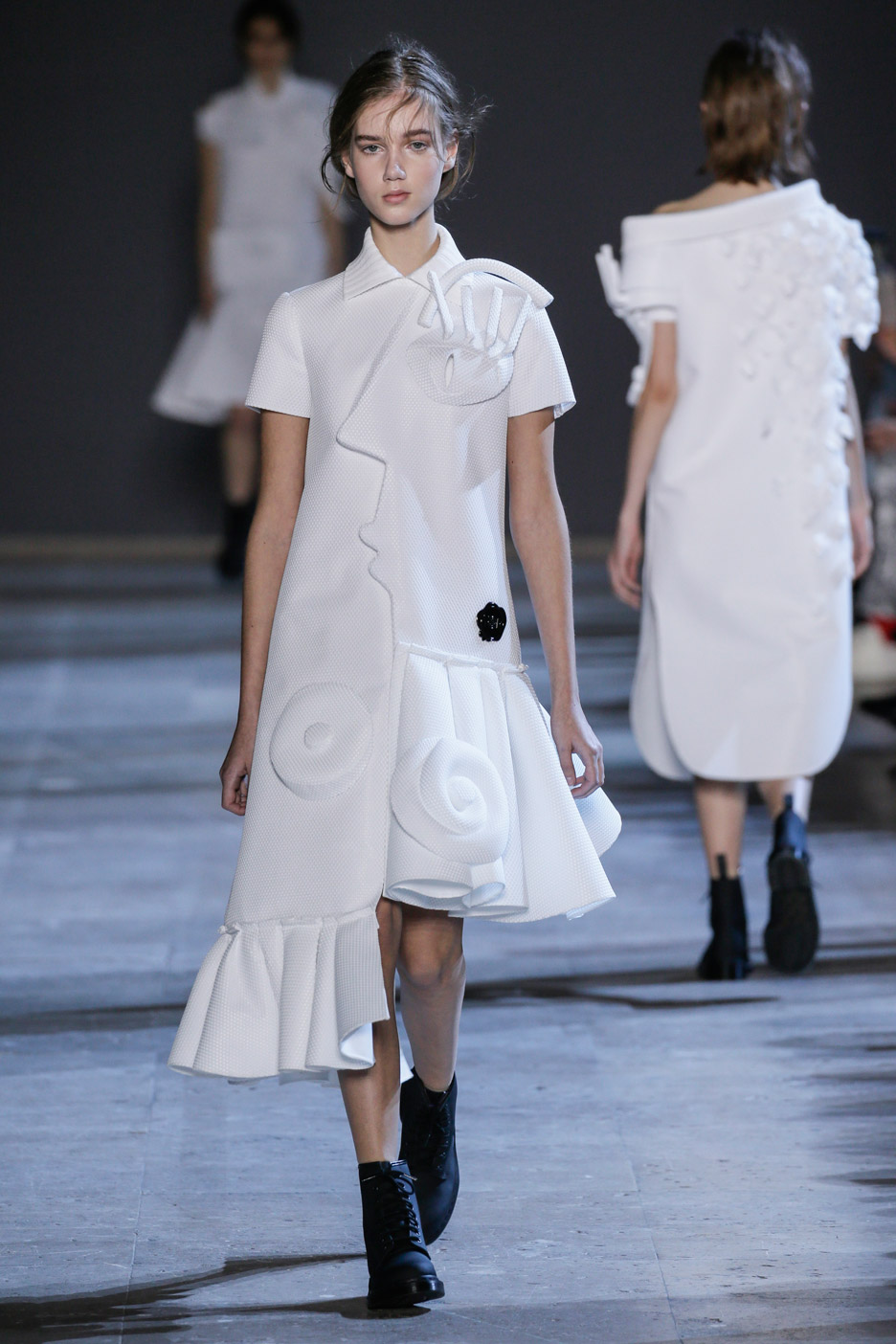
Mismatched facial features and body parts stuck onto, or cut out from, the fabric created abstract portraits.

Each of the garments was made entirely from a white technical piqué – a cotton material woven with fine ribbing, creating a magnified eyelet structure.
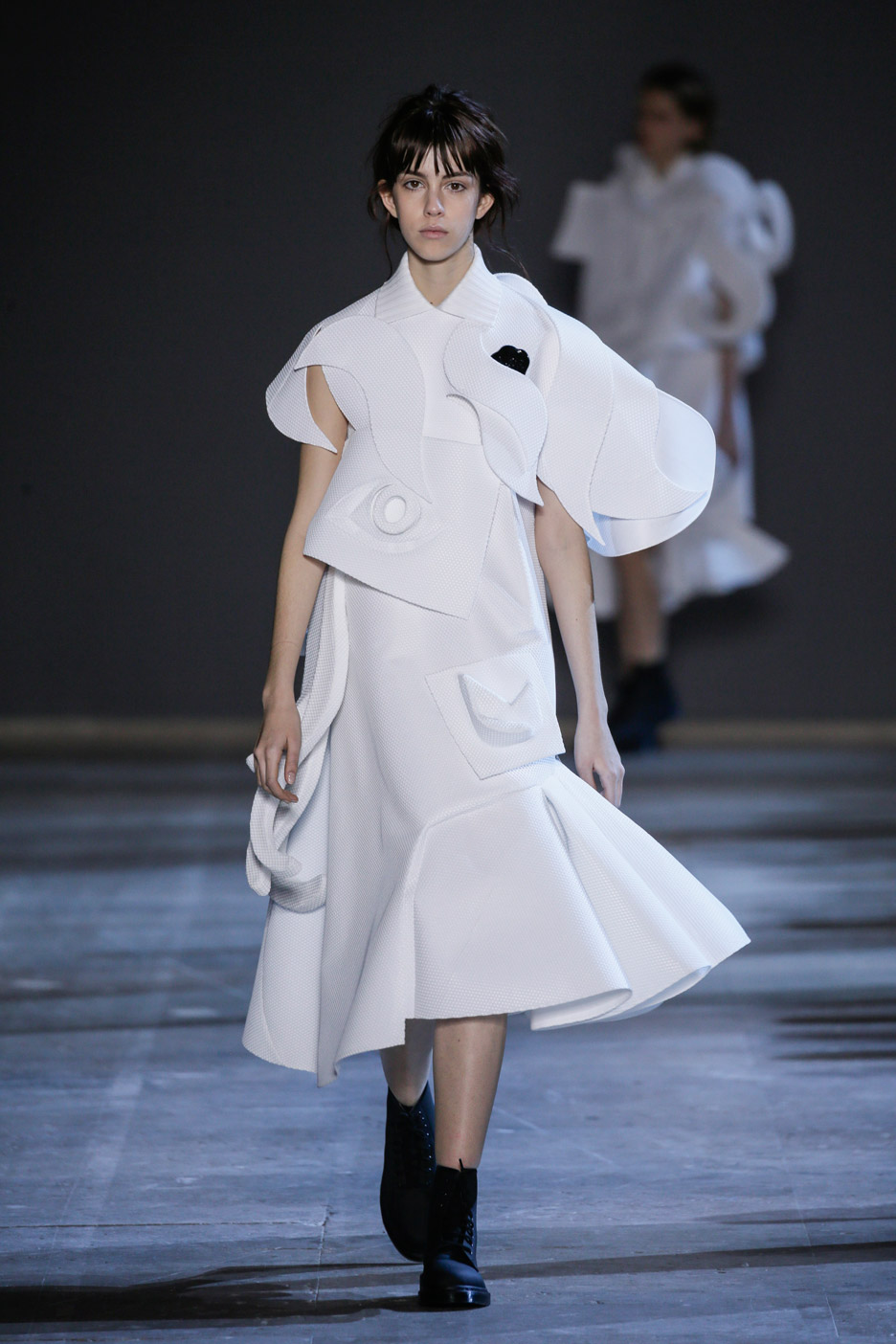
As the performance progressed, the simple looks gave way to more and more sculptural garments.
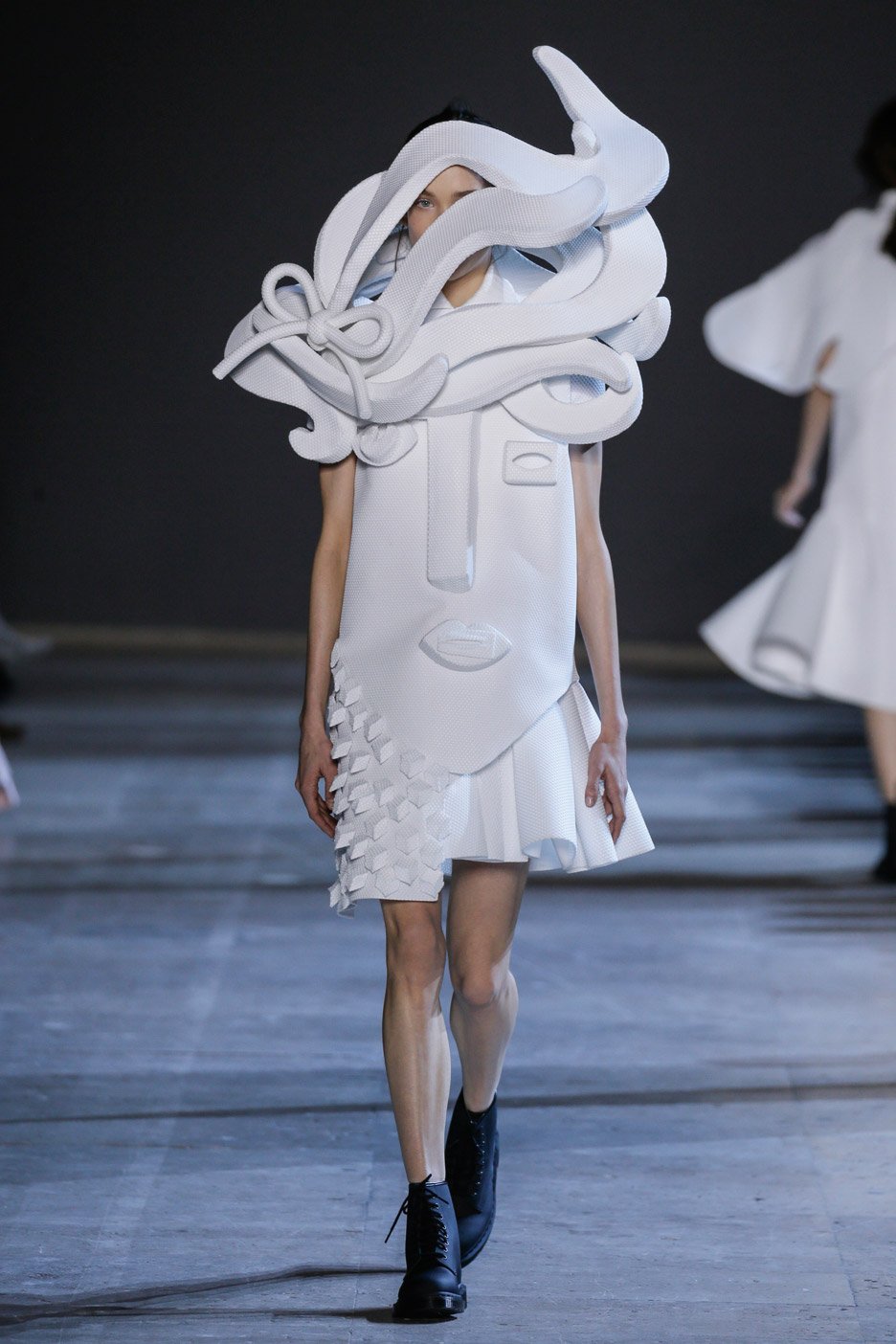
The additions became larger and more exaggerated, with waves of material representing hair extended from shoulders and partially covering faces.

“The designs blur the boundaries between garment and sculpture, and question the relationship between wearer and clothing, sometimes overtaking the body and obscuring the face of the wearer,” said Viktor & Rolf.
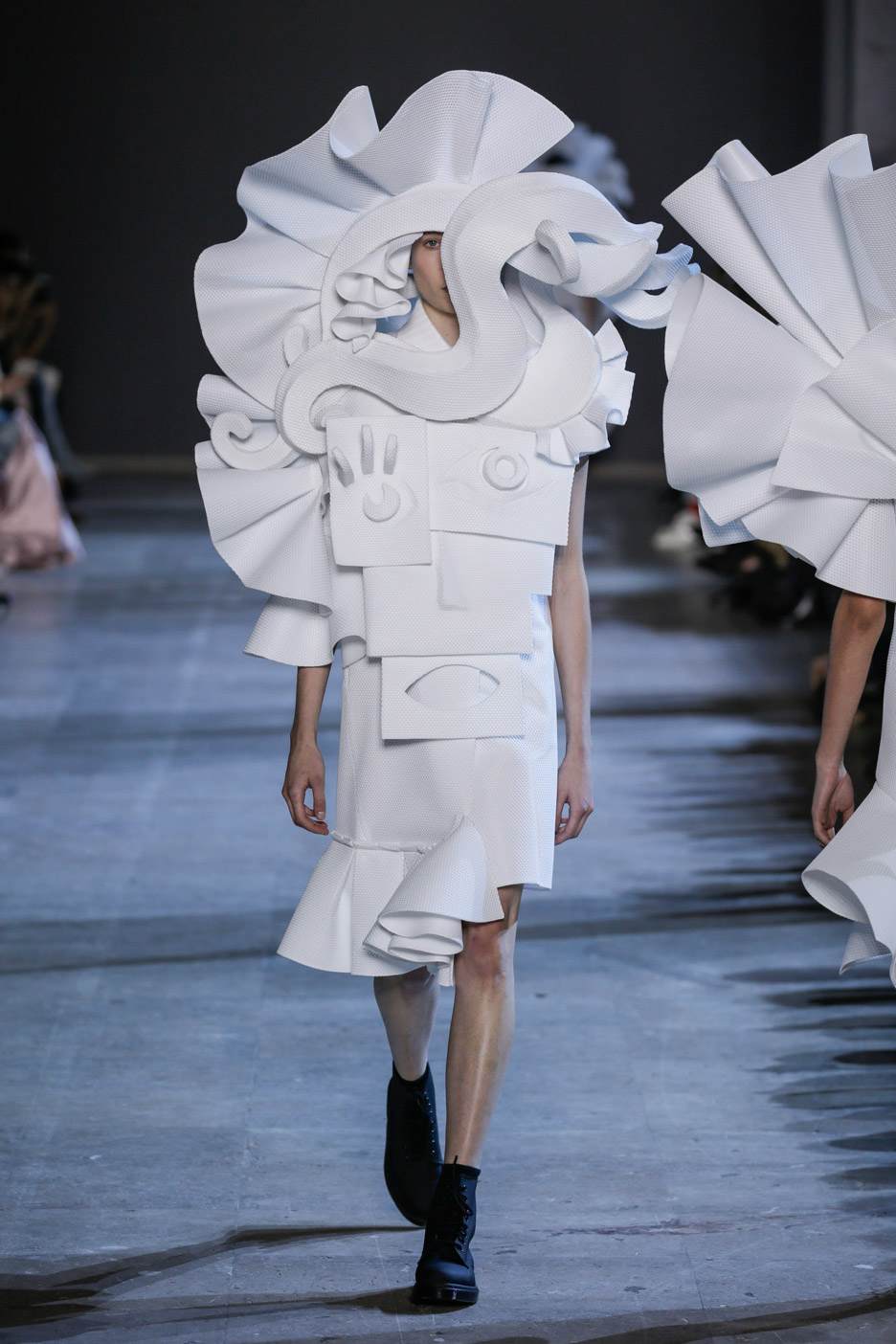
Asymmetric silhouettes and frilled hems were combined to give a “spontaneous, thrown-together look”.

“The effect of rapid improvisation is deceptive however: every seemingly random cut, blotch or chip is meticulously hand finished,” the house said.
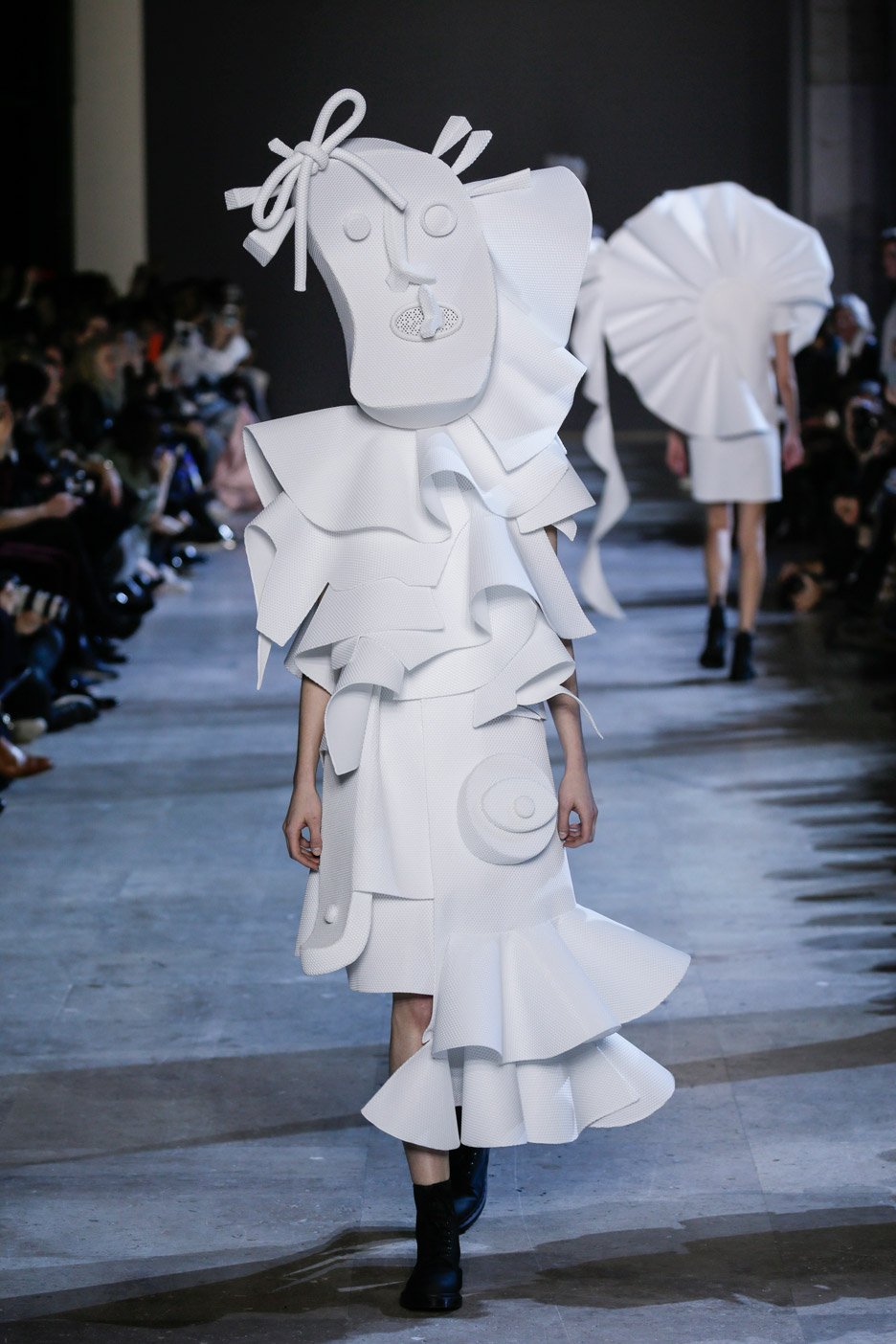
Gradually exaggerated, the later designs fully masked the models – who could only see the catwalk through subtle perforations in the fabric.
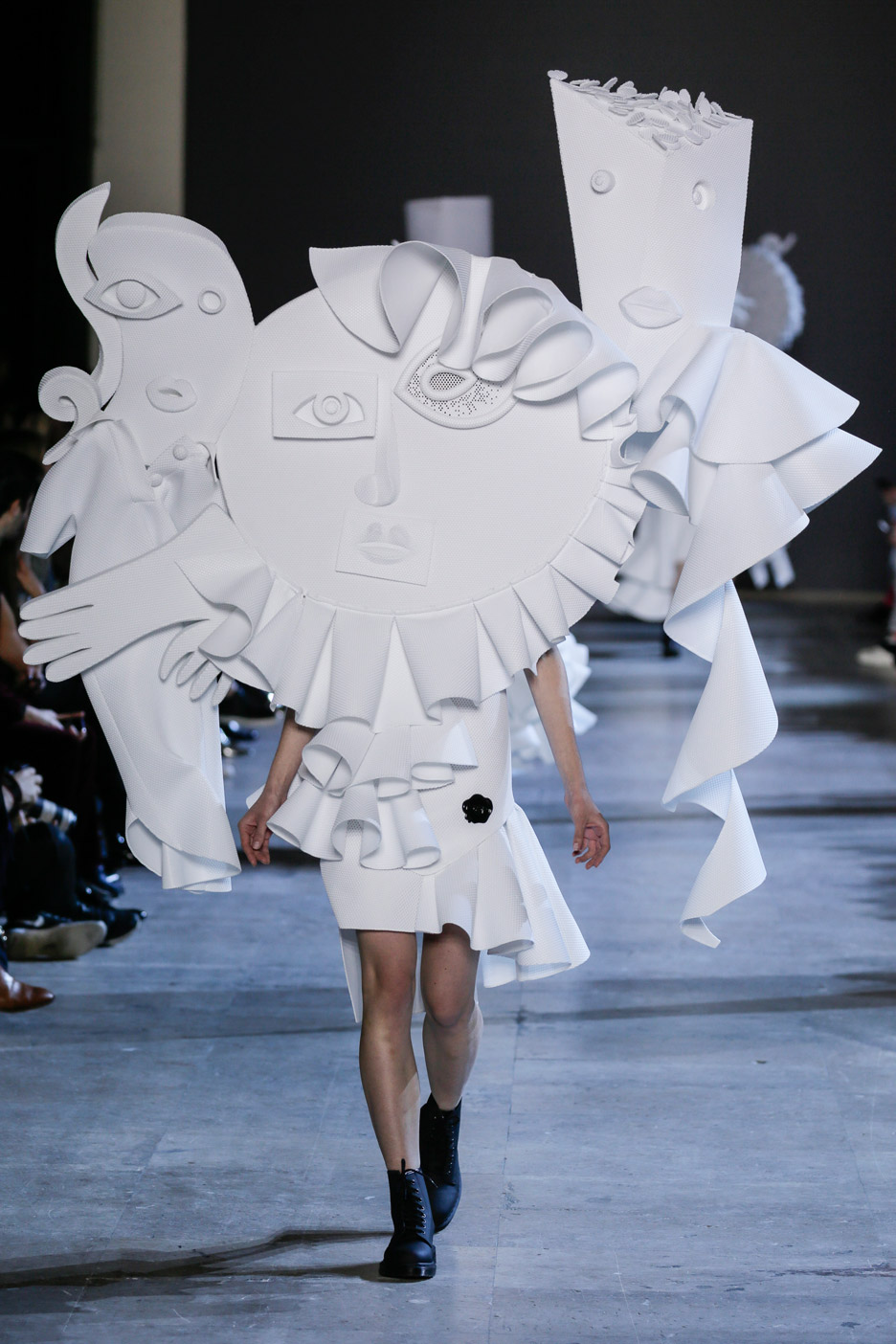
Some looks incorporated a number of Cubist faces into single outfits, either side by side to form extra-wide pieces or stacked up like the faces found on totem poles.
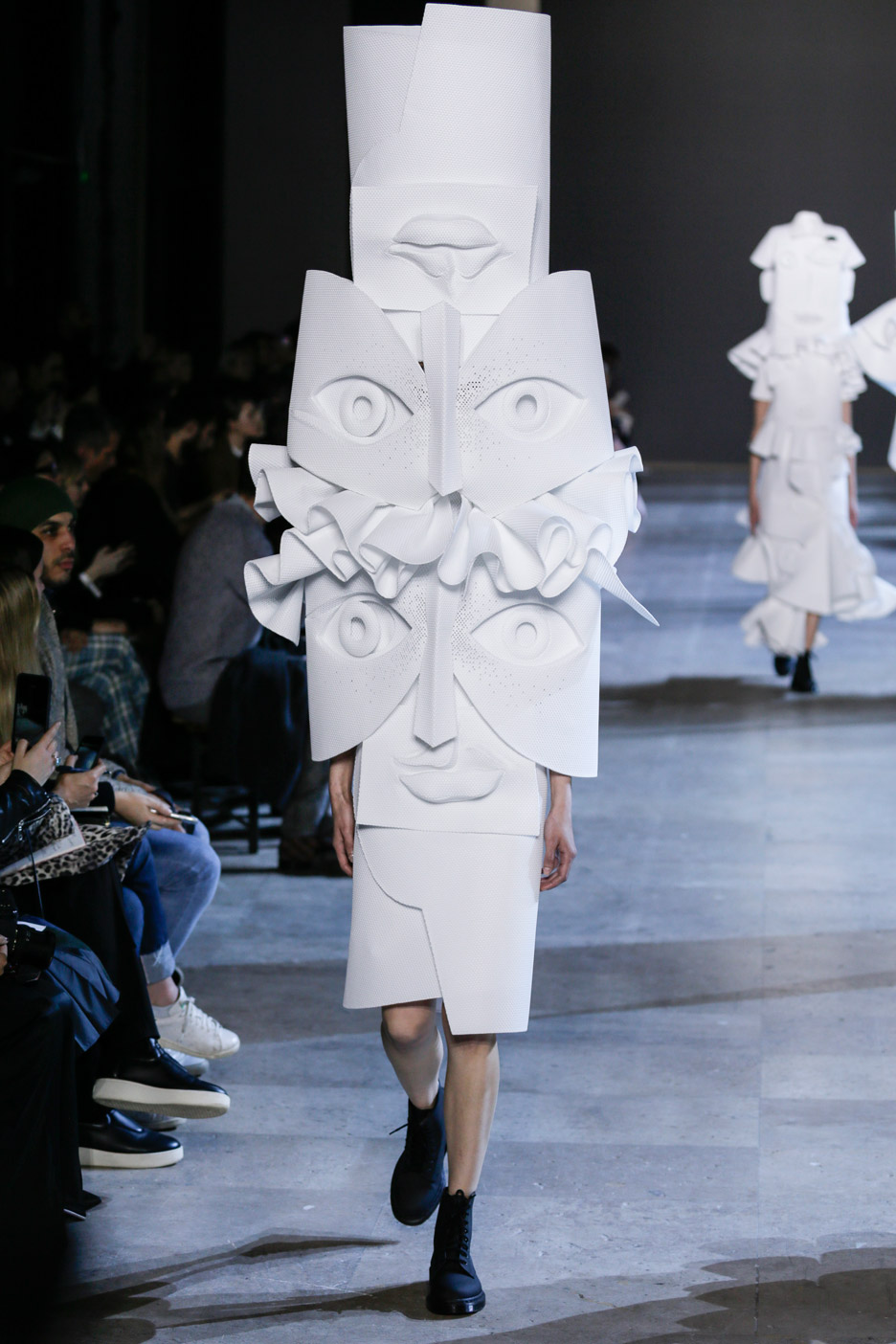
The final garment features the shape of a standard polo shirt mounted high above where the wearer’s head would be, on top of layered portions.
To complete the styling, the all-white garments were juxtaposed with black boots from UK footwear brand Dr Martens.
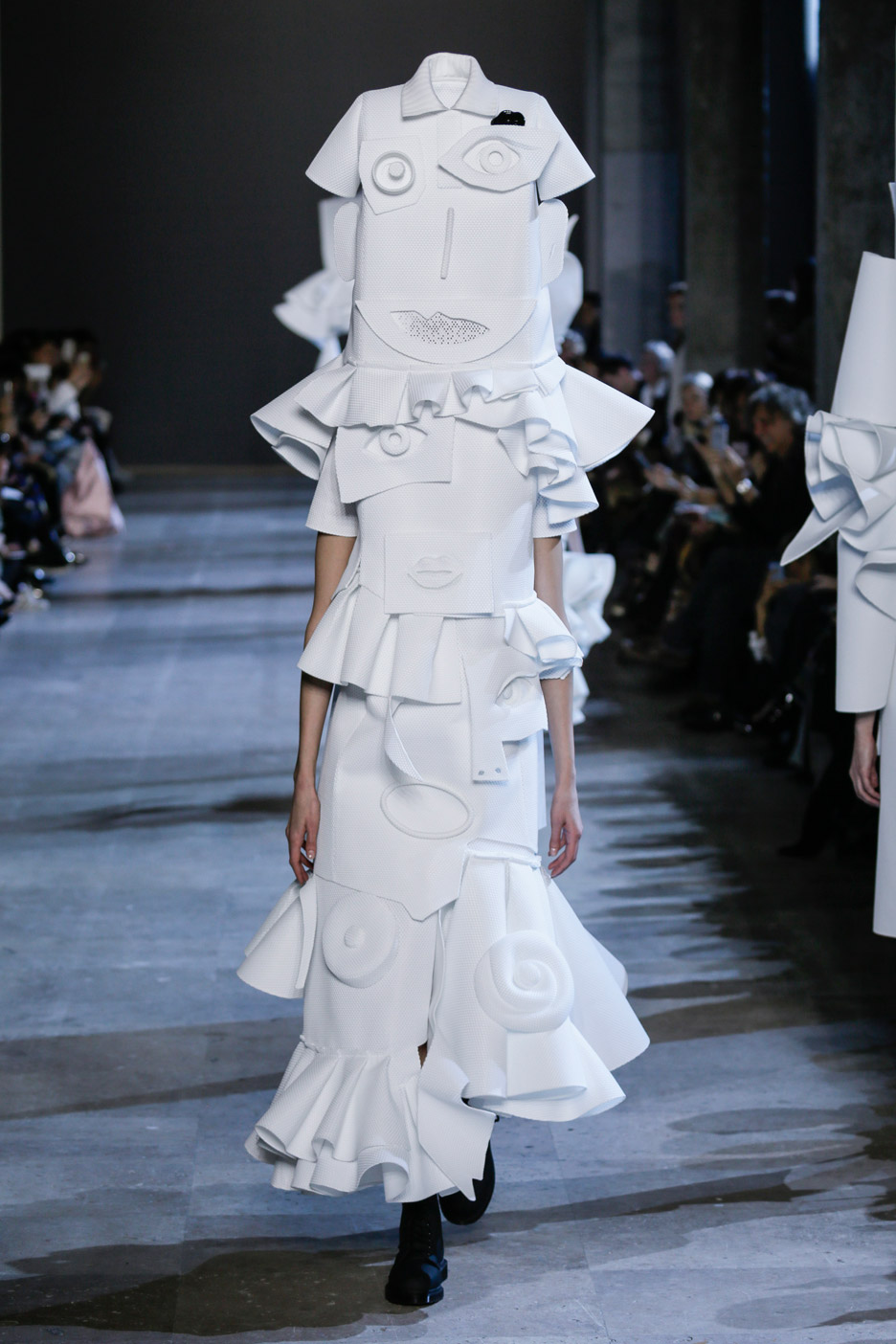
A capsule collection derived from the haute-couture designs – comprising a white technical piqué polo dress, tunic and polo shirt – will be available for pre-order from luxury online fashion retailer Moda Operandi on 30 January 2016. Prices will range from €800 (£610) to €2,800 (£2,100).

The fashion house, founded by Viktor Horsting and Rolf Snoeren in 1993, has previously worked with Studio Job to create the scenography for a number of its shows.
The company opened its first flagship store in Paris in 2013, which was covered in grey felt by Architecture & Associés.


